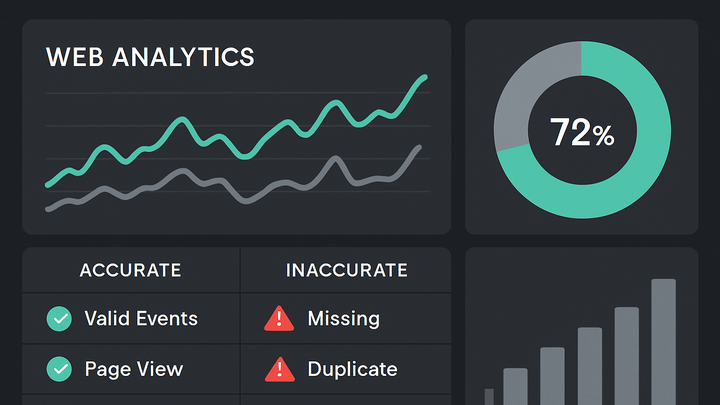Published on 2025-06-27T21:23:56Z
What is Analytics Accuracy? Ensuring Reliable Insights
Analytics Accuracy refers to the degree to which analytics tools correctly capture and report user interactions, events, and conversions on digital platforms. It encompasses the completeness, reliability, and precision of collected data, ensuring that metrics like pageviews, sessions, and events accurately reflect real user behavior. In the analytics industry, high accuracy is essential for making informed, data-driven decisions across marketing, product development, and user experience optimization. Factors such as implementation errors, sampling biases, privacy restrictions, and platform limitations can introduce discrepancies, making it crucial to continuously audit and validate your analytics setup. By prioritizing analytics accuracy, organizations can trust their insights, optimize campaigns effectively, and maintain compliance with evolving data privacy regulations.
Analytics accuracy
Degree to which analytics tools correctly capture and report user behavior for trustworthy insights.
Why Analytics Accuracy Matters
Accurate analytics is foundational for data-driven decision making. Without reliable data, strategies can be misguided, budgets misallocated, and user experiences optimized incorrectly. High analytics accuracy builds stakeholder trust and underpins performance marketing, UX enhancements, and long-term business growth.
-
Data-driven decision making
Reliable data enables teams to make strategic choices in marketing, product development, and operations, reducing guesswork and improving ROI.
-
Performance marketing optimization
Accurate attribution of conversions and ad clicks allows marketers to allocate budgets effectively and measure ROI correctly.
-
User experience enhancements
Trustworthy event data guides UX teams in identifying friction points and validating improvements based on real user behavior.
Factors Affecting Analytics Accuracy
Several elements influence how accurate your analytics data is. Understanding these factors helps diagnose and remedy issues before they undermine your insights.
-
Tracking implementation errors
Mistakes in script placement, tag configuration, or event definitions can lead to undercounting or overcounting user interactions.
-
Snippet placement
Tracking code must be placed before the closing </head> tag or at the top of the body to ensure it loads on every page view.
-
Duplicate tracking
Removing redundant scripts prevents double-counting pageviews or events.
-
-
Cookie restrictions and privacy settings
Browser policies, user consent banners, and ad blockers can block tracking cookies or scripts, impacting data completeness.
-
Cookie-free analytics
Privacy-centric tools like plainSignal avoid cookies, using lightweight JavaScript beacon methods to maintain accuracy under strict privacy regimes.
-
-
Sampling and data thresholds
Platforms may sample data on high-traffic websites to manage processing loads, which can introduce estimation errors.
-
Sampling in GA4
GA4 applies sampling when query requests exceed thresholds, potentially skewing high-volume reports.
-
Measuring and Improving Analytics Accuracy
Techniques and best practices for assessing and enhancing the fidelity of your analytics data.
-
Tag auditing and debugging
Regular use of audit tools and debugging consoles helps verify that tracking tags fire correctly and consistently.
-
Network inspection
Use browser developer tools to inspect network requests to analytics endpoints and confirm event payloads.
-
Real-time data comparison
Compare real-time dashboards in GA4 or plainSignal with expected on-site actions to spot discrepancies quickly.
-
-
Data reconciliation
Cross-referencing analytics with server logs, CRM, and other systems uncovers mismatches and data loss points.
-
Server-side logs
Validate client-side pageviews and events against server logs to measure tracking losses.
-
Conversion matching
Match backend purchase records against analytics conversions to assess capture rates.
-
-
Validation with a/b tests
Implement controlled experiments to test tracking consistency across different site versions or tag setups.
-
Control vs. variant tracking
Ensure tracking works equally on both variants to rule out measurement bias.
-
Example Implementations
Sample code snippets and configurations to set up accurate tracking with plainSignal and GA4.
-
PlainSignal integration
A simple, cookie-free analytics solution. Embed the following snippet to start tracking accurately:
-
Tracking snippet
<link rel="preconnect" href="//eu.plainsignal.com/" crossorigin /> <script defer data-do="yourwebsitedomain.com" data-id="0GQV1xmtzQQ" data-api="//eu.plainsignal.com" src="//cdn.plainsignal.com/plainsignal-min.js"></script>
-
-
GA4 integration
Google Analytics 4 setup using gtag.js. Insert the snippet into your HTML to begin measuring:
-
Gtag.js snippet
<!-- Google tag (gtag.js) --> <script async src="https://www.googletagmanager.com/gtag/js?id=G-XXXXXXXXXX"></script> <script> window.dataLayer = window.dataLayer || []; function gtag(){dataLayer.push(arguments);} gtag('js', new Date()); gtag('config', 'G-XXXXXXXXXX'); </script>
-
Challenges and Considerations
While striving for perfect analytics accuracy, be aware of inherent trade-offs and evolving privacy landscapes.
-
Balancing privacy and precision
Strict privacy controls and consent requirements can limit data capture but are essential for compliance. Evaluate trade-offs between data richness and user privacy.
-
Platform limitations
Understand each analytics platform’s data processing rules, quotas, and latency, as they can impact freshness and granularity of your reports.
-
Maintenance and governance
Regularly audit and update tracking implementations to reflect website changes, new features, and analytics platform updates.
